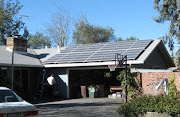I am of the opinion Carbon Emission reduction through the promotion of solar energy, will be far greater than anything the Government is currently planning, and will assist Australian households in not only becoming greener, but in easing the financial pressures on these families. With Government schools, Public Service buildings, factories etc similarly converted the cost saving can be astounding to both the environment and to the schools and organizations themselves. And all this without the need for an Emission Trading Scheme which is due to increase the cost across the board of food, petrol and other items we have come to regard as essential.
I believe the use of solar energy is a far simpler solution to reducing Carbon Emissions, which will reduce emissions far sooner than any Emission Trading Scheme could, as it is aimed at reducing the emissions emitted, and will show a repayment in financial terms to Australians for their efforts in ‘Greening Australia’. It seems the Government is intent on following the European Union lead rather than approach this problem in a way that suits Australian conditions
To start, the Government will need to provide rebates and subsidies which are aimed at assisting all homeowners to convert their homes to solar energy. Through Government assistance at this early stage, we can generate up to 70% of the power required to run our homes without using the present carbon intensive measures. The current cost of converting your homes energy to solar is not affordable for most and can cost between $20,000 to $30,000 and possibly more dependent on the size of the home and your energy needs. People do not own their home long enough to see the return on this type of outlay as the likely energy payback of a typical domestic sized rooftop grid connected solar conversion is approximately four years, so government assistance will be required.
Part of our surplus budget funds can be used for this purpose through non-interest loans available to all and could be repaid through individual tax increases over an agreed period of time, or recouped on the sale of the home, whichever is the sooner
As a bonus to the above we would be implementing measures that will reduce costs in households for essential supplies. The Solar energy system is reported to result in a offset of approximately 105,203kgs of CO2 over a 30 year period from one residential house. If these figures are even close the reduction in CO2 is staggering and with up to a 70% reduction in your electrical bill, this is great for the environment and friendly to the family budget. As coal-fired electricity generating stations are said to be producing up to 50% of Australia’s Carbon Emissions at present a reduction in demand of up to 70% per household will reduce the amount of emissions at this source. (http://www.solarcity.com/tabid/281/Default.aspx ) (http://www.urbanecology.org.au/topics/solarpanels.html)
Secondly the Government should encourage people to purchase electric bikes and scooters, without a need for license and registration for vehicles up to 500w or 50cc motors. This will assist in reducing emissions, and will force the petrol companies to reduce petrol prices due to the reduction in demand. This will then have a ongoing effect with other supplies such as food etc due to reduced petrol costs etc.
Further emission savings could be achieved with discount in registration costs for vehicles using cleaner solutions such as Electric, LPG or Diesel. Although the Government will need to ensure some form of regulation to keep the sale price of these fuels steady, at least initially. This will result in an increase in greener vehicles being sold. Tesla now have released a vehicle that runs solely using Electric power, it will go from 0 – 100kmh in 4 seconds and can travel at 200kmh. It will do 350kms in a charge that is equivalent to 250 mpg (US) = 0.9408583 liters/100 km. So the technology has arrived and is only a matter of time before it will be available at a price for we all can afford.
A matter for serious consideration should be closing our city centers to general traffic, and the introduction of a congestion tax, with a time of day restriction on heavy vehicle traffic and deliveries, this will reduce the congestion in the city, and alleviate the carbon emissions produced by vehicles that can only travel at a snails pace there anyway. This would mean city workers would use the current public transport arrangements, or be able to use bicycles, e-bikes, scooters, and even roller blades safely, leading to not only reduced carbon emissions, but would show an improvement in the health and fitness of many of these workers. The increase in demand on public transport would mean the Infrastructure fund would need to upgrade these facilities.
Of course I have not even broached other approaches that could well be used in conjunction with these measure such as wind power, but that was as a result of our ability to use global warming, with increased sunlight to our advantage rather then be the victims of it, where wind would be better used as a back up to solar power.
These ideas are based on the use of existing technology, the ability to implement these measures fairly immediately and with an eye on the larger picture for Australians in general. This system is workable and good for the environment, for families, and our future. If enough people become as convinced as me, we may just be able to pitch this at the politicians and set them thinking about solutions that can benefit us all.
Kevin
Thursday, July 17, 2008
Subscribe to:
Post Comments (Atom)










No comments:
Post a Comment